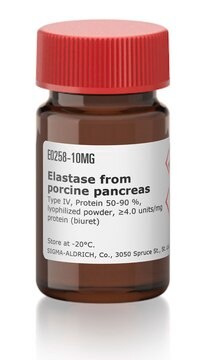C8051
Collagenase from Clostridium histolyticum
Sigma Blend Type H, ≥1.0 FALGPA units/mg solid
Synonym(s):
Clostridiopeptidase A
Sign Into View Organizational & Contract Pricing
All Photos(2)
About This Item
Recommended Products
Quality Level
form
powder
caseinase activity
≥10 units/mg solid
specific activity
≥1.0 FALGPA units/mg solid
mol wt
68-130 kDa
storage temp.
−20°C
Looking for similar products? Visit Product Comparison Guide
Application
Collagenase from Clostridium histolyticum has been used:
- to harvest osteosarcoma 143B cells from collagen scaffold
- in tissue digestion of islets and carotid artery
- in the digestion of chorionic villi
- in enzymatic dissociation for ATP-based tumour chemosensitivity assay (ATP-TCA) in solid tumors
Biochem/physiol Actions
Clostridium histolyticum produces two classes of collagenases. Clostridial collagenases are found to be highly effective than mammalian collagenases. It is capable of cleaving at multiple cleavage sites within the collagen triple helix. It is implicated in the bacterial invasion in gas gangrene.
Effective release of cells from tissue requires the action of both collagenase enzymes and the neutral protease. Collagenase is activated by four gram atom calcium (Ca2+) per mole enzyme. The culture filtrate is thought to contain at least 7 different proteases ranging in molecular weight from 68-130 kDa. The pH optimum is 6.3-8.8. The enzyme is typically used to digest the connective components in tissue samples to liberate individual cells. Collagenase treatment can cause some cells to die. Typically, concentrations varying from 0.1 to 5 mg/mL is used for digestion. The duration of reaction varyies from 15 minutes to several hours to yield a satisfactory efficiency of cell dissociation, without causing too much cell death. Krebs Ringer buffer with calcium and BSA is preffered and Zn2+ is required for activity. This enzyme is tested for the release of hepatocytes at approximately 1 mg/mL conc., in a total volume of 100 mL for each rat liver.
Collagenase is activated by four gram atom calcium per mole enzyme. It is inhibited by ethylene glycol-bis(beta-aminoethyl ether) - N, N, N′,N′-tetraacetic acid, beta-mercaptoethanol, glutathione, thioglycolic acid and 8-hydroxyquinoline.
Unit Definition
One collagen digestion unit (CDU) liberates peptides from collagen from bovine achilles tendon equivalent in ninhydrin color to 1.0 μmole of leucine in 5 hours at pH 7.4 at 37 °C in the presence of calcium ions. One FALGPA hydrolysis unit hydrolyzes 1.0 μmole of furylacryloyl-Leu-Gly-Pro-Ala per min at 25°C. One Neutral Protease unit hydrolyzes casein to produce color equivalent to 1.0 μmole of tyrosine per 5 hr at pH 7.5 at 37°C. One Clostripain Unit hydrolyzes 1.0 μmole of BAEE per min at pH 7.6 at 25°C in the presence of DTT.
substrate
Product No.
Description
Pricing
Signal Word
Danger
Hazard Statements
Precautionary Statements
Hazard Classifications
Eye Irrit. 2 - Resp. Sens. 1 - Skin Irrit. 2 - STOT SE 3
Target Organs
Respiratory system
Storage Class Code
11 - Combustible Solids
WGK
WGK 1
Flash Point(F)
Not applicable
Flash Point(C)
Not applicable
Personal Protective Equipment
dust mask type N95 (US), Eyeshields, Gloves
Choose from one of the most recent versions:
Already Own This Product?
Find documentation for the products that you have recently purchased in the Document Library.
Customers Also Viewed
The in vitro effect of gefitinib (Iressa) alone and in combination with cytotoxic chemotherapy on human solid tumours
Knight LA, et al.
BMC Cancer, 4(1), 83-83 (2004)
Exendin-4 improves yield and function of isolated pre-weaned porcine islets
Lau H, et al.
Journal of Endocrinology and Diabetes, 5(5), 1-7 (2018)
Erik J Behringer et al.
British journal of pharmacology, 166(2), 774-787 (2011-12-16)
Electrical conduction along endothelium of resistance vessels has not been determined independently of the influence of smooth muscle, surrounding tissue or blood. Two interrelated hypotheses were tested: (i) Intercellular conduction of electrical signals is manifest in endothelial cell (EC) tubes;
Upregulated TRPC3 and downregulated TRPC1 channel expression during hypertension is associated with increased vascular contractility in rat
Noorani MM, et al.
Frontiers in Physiology, 2, 42-42 (2011)
Ming Yu et al.
Journal of applied physiology (Bethesda, Md. : 1985), 93(4), 1391-1399 (2002-09-18)
In contrast to its constrictor effects on peripheral arteries, 20-hydroxyeicosatetraenoic acid (20-HETE) is an endothelial-dependent dilator of pulmonary arteries (PAs). The present study examined the hypothesis that the vasodilator effects of 20-HETE in PAs are due to an elevation of
Protocols
This procedure may be used for Collagenase products.
Our team of scientists has experience in all areas of research including Life Science, Material Science, Chemical Synthesis, Chromatography, Analytical and many others.
Contact Technical Service![N-[3-(2-Furyl)acryloyl]-Leu-Gly-Pro-Ala](/deepweb/assets/sigmaaldrich/product/structures/805/876/96b5fb57-71c8-4c6b-b5d2-fafe7374cd85/640/96b5fb57-71c8-4c6b-b5d2-fafe7374cd85.png)








